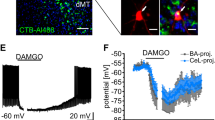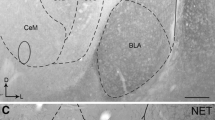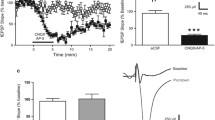Abstract
The amygdala plays an important role in the integration of responses to noxious and fearful stimuli. Sensory information from many systems is integrated in the lateral and basolateral amygdala and transmitted to the central amygdala, the major output nucleus of the amygdala regulating both motor and emotional responses. The network of intercalated cells (ITC) which surrounds the lateral and basolateral amygdala and serves to modulate information flow from the lateral amygdala to the central nucleus, express a very high local concentration of mu-type opioid receptors. Loss of the ITC neurons impairs fear extinction. We demonstrate here that exposure of rats to a severe stress experience resulted in a marked downregulation of the level of expression of mu opioid receptors in the ITC nuclei over a period of at least 24 h after the end of the stress exposure. The endogenous opioid dynorphin is also expressed in the central and ITC nuclei of the amygdala. Following stress exposure, we also observed an increase in the expression in the more lateral regions of the central amygdala of pro-dynorphin mRNA and a peptide product of pro-dynorphin with known affinity for mu opioid receptors. It is possible that the downregulation of mu receptors in ITC neurons after stress may result from sustained activation and internalization of mu receptors following a stress-induced increase in the release of endogenous opioid peptides.





Similar content being viewed by others

References
Amir A, Amano T, Pare D (2011) Physiological identification and infralimbic responsiveness of rat intercalated amygdala neurons. J Neurophysiol 105:3054–3066
Arttamangkul S, Heinz DA, Bunzow JR, Song X, Williams JT (2018) Cellular tolerance at the µ-opioid receptor is phosphorylation dependent. eLife. 1:1. https://doi.org/10.7554/eLife.34989
Braga MF, Aroniadou-Anderjaska V, Manio ST, Hough CJ, Li H (2004) Stress impairs α1A adrenoceptor mediated noradrenergic facilitation of GABAergic transmission in the basolateral amygdala. Neuropsychopharmacology 29:45–58
Cone RI, Weber E, Barchas JD, Goldstein A (1983) Regional distribution of dynorphin and neoendorphin peptides in rat brain, spinal cord and pituitary. J Neurosci 3:2146–2152
Corder G, Ahanonu B, Grewe BJ, Wang D, Schnitzer MJ, Scherrer G (2019) An amygdala neural ensemble that encodes the unpleasantness of pain. Science 363:276–281
Goodman RR, Pasternak GW (1985) Visualization of µ1 opiate receptors in rat brain by using a computerized autoradiographic subtraction technique. Proc Natl Acad Sci USA 82:6667–6671
Gomes I, Sierra S, Lueptov L, Gupta A, Gouty S, Margolis EB, Cox BM, Devi LA (2020) Biased signaling by endogenous opiod peptides. Proc Natl Acad Sci USA 117:11820–11828
Gouty S, Brown JM, Rosenberger J, Cox BM (2010) MPTP treatment increases expression of pre-pronociceptin/orphanin FQ mRNA in a subset of substantia nigra reticulata neurons. Neuroscience 169:269–278
Höllt V (1986) Opioid peptide processing and receptor selectivity. Ann Rev Pharmacol Toxicol 26:59–77
Jiang X, Xing G, Yang C, Verma A, Zhang L, Li H (2009) Stress impairs 5HT2A receptor-mediated serotonergic facilitation of GABA release in juvenile rat basolateral amygdala. Neuropsychopharmacology 34:410–423
Letchworth SR, Mathis JP, Rossi GC, Bodnar RJ, Pasternak GW (2000) Autoradiographic localization of 125I[Tyr14] orphanin FQ/nociceptin(1–11) binding sites in rat brain. J Comp Neurol 423:319–329
Likhtik E, Popa D, Apergis-Schoute J, Fidacaro GA, Paré D (2008) Amygdala intercalated neurons are required for expression of fear extinction. Nature 454:642–645
Manion ST, Gamble EH, Li H (2007) Prazosin administered prior to inescapable stressor blocks subsequent exaggeration of acoustic startle response in rats. Pharmacol Biochem Behav 86:559–565
Mansour A, Hoversten MT, Taylor LP, Watson SJ, Akil H (1995) The cloned mu, delta and kappa receptors and their endogenous ligands: evidence for two opioid peptide recognition cores. Brain Res 700(1–2):89–98
Maren S, Quirk GJ (2004) Neuronal signalling of fear memory. Nature Rev Neurosci 5:844–852
Marowsky A, Yanagawa Y, Obata K, Vogt KE (2005) A specialized subclass of interneurons mediates dopaminergic facilitation of amygdala function. Neuron 48:1025–1037
Meiss E, Gondin AB, Yousuf A, Steinborn R, Mösslein N, Yang Y, Göldner M, Ruland JG, Bünemann M, Krasel C, Christie MJ, Halls ML, Schulz S, Canals M (2018) Multisite phosphorylation is required for sustained interaction with GRKs and arrestins during rapid µ-opioid receptor desensitization. Sci Signal 11:eaas9609
Paxinos G, Watson C (2005) The rat brain in stereotaxic coordinates, 5th edn. Academic Press, London
Pert CB, Kuhar MJ, Snyder SH (1976) Opiate receptor: Autoradiographic localization in rat brain. Science 73:3729–3733
Recht LD, Kent J, Pasternak GW (1985) Quantitative autoradiography of the development of mu opiate binding sites in rat brain. Cell Mol Neurobiol 5:223–229
Rossi GC, Pellegrino M, Shane R, Abbadie CA, Dustman J, Jimenez C, Bodnar RJ, Pasternak GW, Allen RG (2002) Characterization of rat prepro-orphanin FQ/nociceptin(154–181): processing in supraspinal sites. J Pharmacol Exp Ther 300:257–264
Royer S, Martina M, Paré D (1999) An inhibitory interface gates impulse traffic between the input and output stations of the amygdala. Neuroscience 19:10575–10583
Santhappan R, Crowder AT, Gouty S, Cox BM, Cote TE (2015) Mu opioid receptor activation enhances regulator of G protein signaling 4 association with the mu opioid receptor/G protein complex in a GTP-dependent manner. J Neurochem 135:76–78
Seizinger BR, Grimm C, Höllt V, Herz A (1984) Evidence for a selective processing of proenkephalin B into different opioid peptide forms in particular regions of rat brain and pituitary. J Neurochem 42:447–457
Shane R, Lazar DA, Rossi GC, Pasternak GW, Bodnar RJ (2001) Analgesia elicited by OFQ/nociceptin and its fragments from the amygdala of rats. Brain Res 907:109–116
Servatius RJ, Ottenweller JE, Natelson BH (1995) Delayed startle sensitization distinguishes rats exposed to one or three stress sessions: further evidence toward an animal model of PTSD. Biol Psychiatry 38:539–546
Strobel R, Marek HM, Gooch RK, Sullivan PS (2015) Prefrontal and auditory input to intercalated neurons of the amygdala. Cell Rep 10:1435–1442
Weber E, Evans CJ, Barchas JD (1982) Predominance of the amino-terminal octapeptide fragment of dynorphin in rat brain regions. Nature 299:77–79
Williams JT, Christie MJ, Manzoni O (2001) Cellular and synaptic adaptations mediating opioid dependence. Physiol Rev 81:299–343
Winters BL, Gregoriou GC, Kissiwaa SA, Wells OA, Medagoda DI, Hermes SM, Burford NT, Alt A, Aicher SA, Bagley EE (2017) Endogenous opioids regulate moment-to-moment neuronal communication and excitability. Nat Commun. https://doi.org/10.1038/ncomms14611
Zhang Y, Pan Y-X, Kolesnikov Y, Pasternak GW (2006) Immunohistochemical labeling of the mu opioid receptor carboxy terminal splice variant mMOR-1B4 in the mouse central nervous system. Brain Res 1059:33–43
Acknowledgments
We thank Dr. He Li, Department of Psychiatry, Uniformed Services University, for use of equipment and for helpful advice and discussion and Dr. E. Weber for gift of the antiserum for Dynorphin A(1-8).
Funding
This work was supported by USAMRMC Research Grant #W81XWH 0820575. The research was reviewed and approved by the Uniformed Services University Animal Care and Use Committee (IACUC) in accordance with all applicable Federal regulations governing the protection of animals in research.
Author information
Authors and Affiliations
Corresponding author
Ethics declarations
Conflict of interest
The authors declare that they have no financial interest in any commercial product, service or organization providing support for this research.
Additional information
Publisher's Note
Springer Nature remains neutral with regard to jurisdictional claims in published maps and institutional affiliations.
The opinions or assertions contained herein are the private views of the authors and are not to be construed as official or reflecting the views of the U.S. Department of Defense or the Uniformed Services University of the Health Sciences.
Rights and permissions
About this article
Cite this article
Gouty, S., Silveira, J.T., Cote, T.E. et al. Aversive Stress Reduces Mu Opioid Receptor Expression in the Intercalated Nuclei of the Rat Amygdala. Cell Mol Neurobiol 41, 1119–1129 (2021). https://doi.org/10.1007/s10571-020-01026-7
Received:
Accepted:
Published:
Issue Date:
DOI: https://doi.org/10.1007/s10571-020-01026-7



